
Ballot Party, November 5

syəcəb

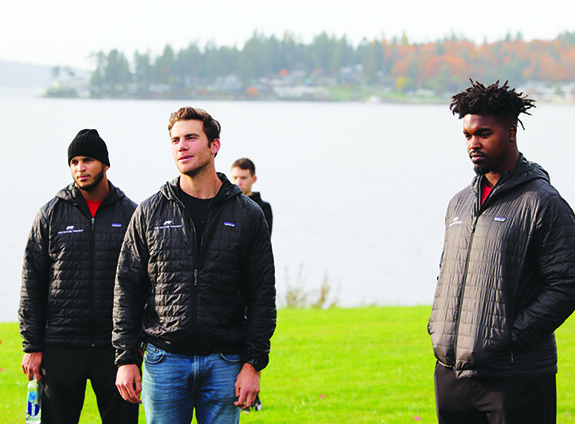
By Kalvin Valdillez, Tulalip News
A large circle formation of about sixty Tulalip citizens congregated outside of the Youth Center on the bluff overlooking Tulalip Bay. The group, consisting of mostly youth, offered two traditional songs to three tall individuals who were standing at the center of the circle. In the distance was a yellow seaplane sitting on the waters of the bay, which the visitors arrived in moments prior. Leaders of the Tulalip Youth Council and previous Tulalip Mountain Camp and Fish Camp attendees were in for quite the surprise on the chilly fall evening of October 22.
“We were asked to be here by Jessica, our Youth Council Advisor,” explained Youth Council Secretary, Shylah Zackuse. “We were told it was going to be a team building experience. But I had no clue there was going to be former Seahawks players here.”
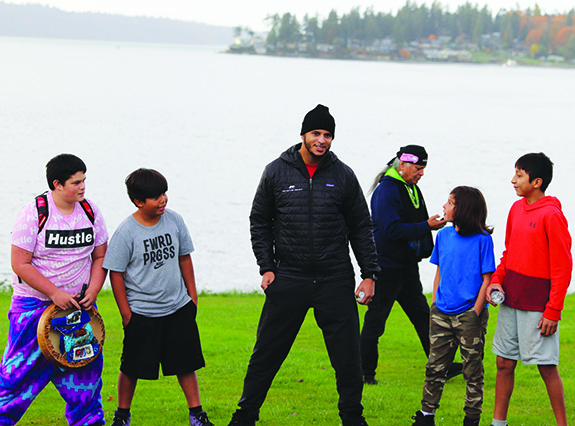
Three years ago, former Seahawks tight end and Super Bowl XLVIII Champion, Cooper Helfet, started a non-profit organization, the Nature Project, dedicated to getting kids outdoors for recreational fun, along with time away from their phone screens. Since then, Cooper has recruited former teammates, as well as a few current NFL players, to participate in the Nature Project. For the visit to Tulalip, Cooper brought along fellow former Seahawks, Jermaine Kearse and Tyrone Swoopes.
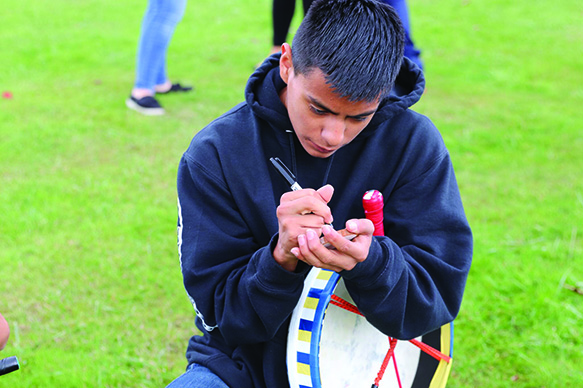
“I grew up in northern California and I had a lot of opportunities to get out into nature, whether that was hiking, camping, surfing or backpacking, it was a big priority in my family to do so,” said Cooper after thanking the people for the traditional songs. “Some of my favorite memories as a kid were doing those things. And as I got older, especially when I started playing with the Hawks and with different teams in my career, I realized a lot of my teammates didn’t get those opportunities. I started getting them outdoors more and they had an amazing experience developing their own relationship with the natural world.
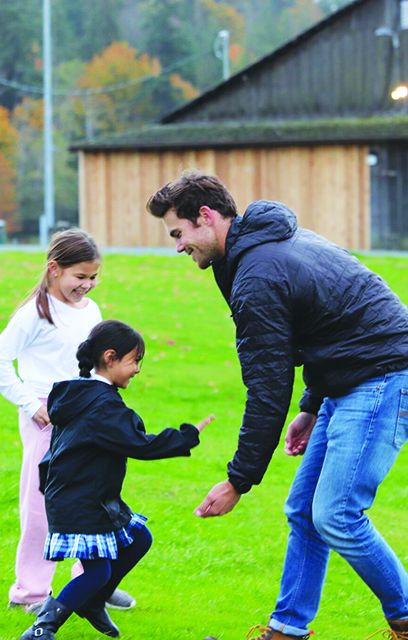
“And I thought, how do we create these types of opportunities for kids? Especially in a time where video games, TV, the internet are exciting, but taking over our world. So I started this project, bringing out athletes to the kids of local communities to get them outdoors and impress upon them the importance of spending time outside.”
After taking time to snap a photo with the crowd, the football stars hung out with the youth, passing a soccer ball around. Approximately thirty kids introduced themselves to the group and stated one outdoor activity they enjoyed such as skateboarding, hiking, softball and basketball. Next, Cooper passed around sharpies and cedar medallions, asking the kids to write down one goal they hoped to accomplish in their lifetime.
“The real mission of the project is to motivate kids to spend more time outside and do so in a way where they can create positive physical memories with friends,” Cooper explained. “And to use that as a tool they can use throughout their life to be reflective and think about their goals and how to overcome adversity. We know that often times it could be hard for youth to relate, listen and let things soak in. One of the assets we have as athletes is we have an ability to connect with kids and know we’re going to have their ears and attention because we gained that beautiful gift of being their role models, so we try to pass that on to them through the Nature Project work.”
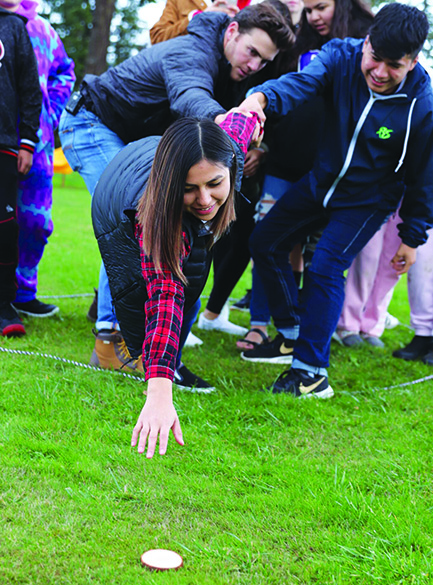
Once everybody’s goals were marked down, the kids had fun participating in an exercise designed to use the power of communication, teamwork, and creativity to find a way to obtain their goals. After putting in plenty of effort and refusing to give up, the kids got a little help from Cooper, Jermaine and Tyrone. However, in order to receive help from the football pros, the youth had to vocalize exactly what they needed from the athletes first.
The youth were shown that it is possible to achieve their aspirations by using teamwork and communication skills. The group then had an open conversation about attaining individual goals through determination, perseverance and utilizing personal resources.
“Perseverance for me is not giving up and overcoming every obstacle,” expressed Jermaine, who is also a Super Bowl XVIII Champ. “Adversity is going to show up in our lives whether it’s in sports, school, life or relationships. For me, in the 2015 NFC Championship against the Green Bay Packers I had four targets, four passes thrown to me, and they were intercepted each time. It was a tough moment but I didn’t feel sorry for myself, I didn’t quit, go in the locker room, or sit on the bench with my head down. I knew there were going to be more opportunities and if I was going to be ready for the next opportunity I had to stay mentally in the game. My next opportunity so happened to be the game winning touchdown. That’s perseverance, not giving up on yourself and continuing to push forward.
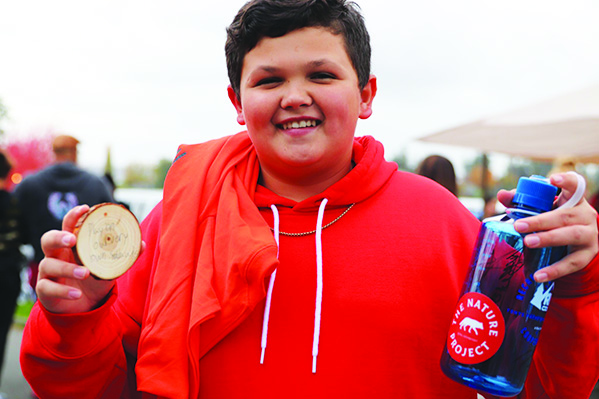
“Sometimes we feel prideful, we have our egos and want to do things on our own. Please know that it’s okay to ask for help. It’s hard to go through life doing everything by yourself. If you have a group of friends or family that are really close to you, if you’re going through hard times in class or struggling, it’s okay to ask for help. Don’t feel ashamed because even the strongest people in the world need help.”
Every year the Tulalip Natural Resources department partners with the YMCA of Snohomish County to bring local youth the outdoor summer camps, Mountain Camp and Fish Camp. Upon hearing about the camps, the Nature Project was interested in hosting an outdoor event with the Tulalip community.
“The Nature Project learned about us through the YMCA,” said Ryan Miller, Tulalip Natural Resources Environmental Liaison. “Their whole goal is to get kids out into nature and have that experience that Cooper had when he was a kid, that he feels turned him into the person he is today. They felt he was a really good fit to do something with Tulalip and our youth. It’s an opportunity for the kids to learn about the importance of team work, perseverance, leadership and gives them skills that will help them throughout their lives.”
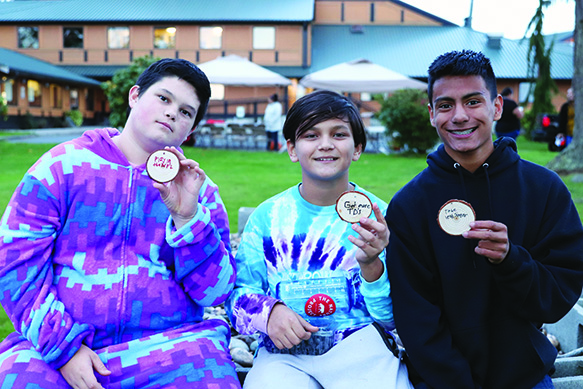
Tulalip youth Seth Montero fell in love with the great outdoors while at the Mountain and Fish Camps. His passion for nature was so strong that when he grew past the camp age limit, he took a course with the YMCA to take on a leadership role at the summertime camps. Seth thanked the former Seahawks for their work promoting outdoor activities.
“Nature is important because it’s all around us and every day we’re losing more and more of it. It’s always good to get outside whenever you have the chance. Go explore new places, appreciate all the views Mother Earth has to offer, because it might not always be there.”
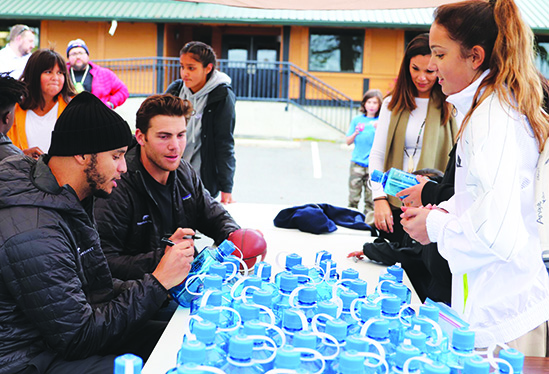
To wrap up the evening, kids were given large water bottles courtesy of REI and all three Nature Project members took a moment to converse with each kiddo as they autographed their names across their bottles.
“It was so awesome,” said Tulalip Youth, Lincoln Pablo. “Jermaine Kearse has always been my inspiration for playing football. His catches are amazing. I always wanted to do what he did and get to the league. For my goal today, I wrote down play on our very own Seattle Seahawks.”
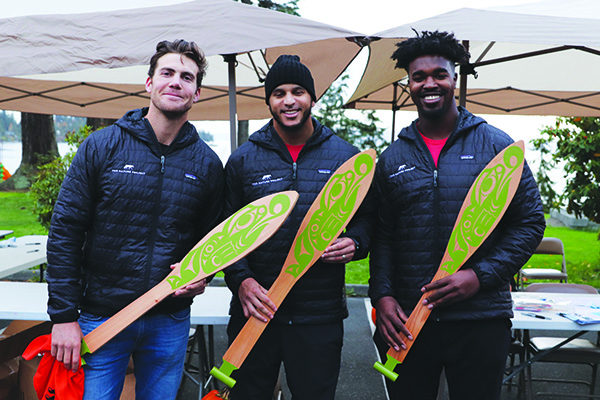
Before taking off in the seaplane, Jermaine and Tyrone were gifted handcrafted masks by Tulalip artist Ty Juvinel, and all three former Seahawks received paddles from the Tulalip Youth.
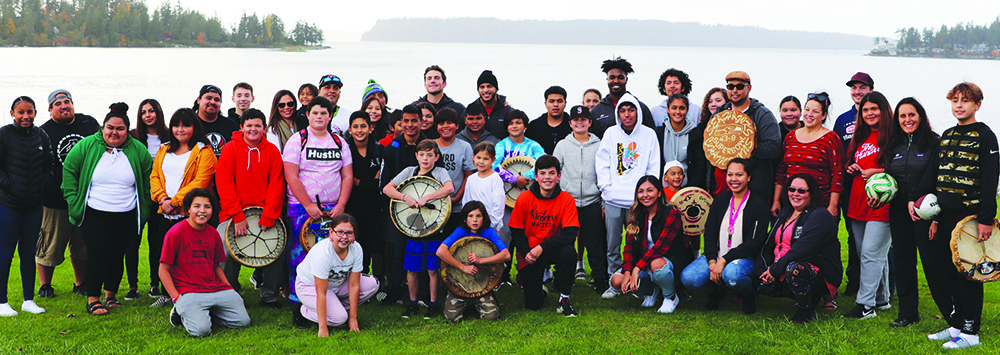
“You live on a beautiful reservation,” Cooper said. “If you’re looking for ways to get involved in outdoor fun, it’s as simple as walking along the beach or adventuring a little east and getting up in the woods. It doesn’t take much. It’s grabbing a neighbor and going for a walk, it doesn’t need be a planned thing. When I think about my childhood, none of my memories were inside paying video games. They were memories I can feel, hear, see and smell and were with friends. 99% of the time they were outdoors. You just got to take the initiative and go do it. Your ancestors were the original stewards of all this land we get to call home, and I just want to express that there’s an insane amount of gratitude that I have for that.”
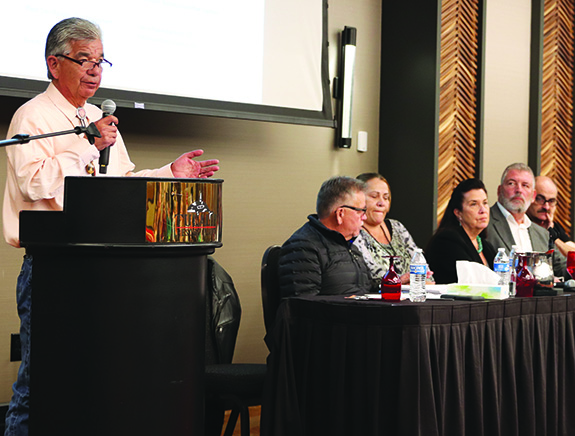
By Kalvin Valdillez, Tulalip News
In 2014 Washington became one of the first states to legalize the use of recreational marijuana after nearly eighty years of prohibition nationwide. Since then, the state has reaped the benefits of cannabis, collecting hundreds of millions of dollars annually from taxes and licensing fees.
Just last year, Tulalip opened the doors at Remedy, a recreational shop that is one of few ran and owned entirely by a tribal nation. The Tribe’s current compact with the state, in regards to Remedy, allows them to put the money collected from excise tax back into the Tribe, while paying the state exactly 0% in taxes.
But as the shop’s name suggests, the Tribe’s focus on the use of marijuana extends far past merely gaining profit from the plant. At Remedy’s grand opening in August of 2018, Tulalip Board of Director (BOD) Les Parks informed the crowd that this was only the beginning of a long relationship between the Tribe and cannabis, announcing a new research project along with a partnership with Stanford University. Perhaps it was due to the long process of opening Remedy or his vision appeared too distant, but the crowd had an overall mixed reaction of skepticism and hope when Les boldly claimed the Tribe would find a cure, or remedy if you will, to end the opioid epidemic with the medical benefits of marijuana.
Back in March, the Tribe held the first Tulalip/Stanford medical cannabis research project meeting, sharing information found during the first round of research with the community and explaining how this study can benefit the Tribe. Initially the Tribe invested $2 million into the two-year research project. During the first meeting Tulalip BOD members assured the people that whatever found during the study is the sole intellectual property of the Tribe, and that they also retain the right to opt out of the contract with Stanford within the two years. Because the research results were positive, the Tribe continued with the project. The Tribe and Stanford Scientists met once more on the evening of October 10 to give tribal members a new update on the research project.
“First and foremost we need to save lives,” said Les. “We know what the opioid addiction is like on this reservation, we’ve seen way too many deaths. Two years ago, we had a declaration by the BOD, a state of emergency on the opioid epidemic and we’ve been aggressively tackling that. Since we’ve done that, our death rate has gone down. But any death due to an opioid addiction is one too many. We are 18 months into our Stanford research project. The board authorized a $2 million budget for Stanford to study the cannabis oil and how it might be able to successfully treat opioid addiction.”
Thousands of deaths are reported nationally from opioid involved overdoses each year. According to the Washington State Department of Health, three thousand deaths by overdose happen here in Washington annually, with a large portion of those occurring in the Marysville, Tulalip and Everett area.
“I’m sure we all know someone who is no longer with us due to this addiction,” Les continued. “The people who are addicted don’t want to be addicted, they don’t want to keep living this way, they want help. We are working with the whole plant oil, which includes over two hundred cannabinoids; the most present cannabinoids are CBD and THC. And what we’ve been finding is truly groundbreaking.”
Up until now, there has been very little, research done specifically on the healing properties marijuana can provide for recovering addicts. But the idea doesn’t seem that farfetched if you take into the account all of the diseases and health issues that the plant aids with in today’s society. Many studies have shown that cannabis can help patients with chronic pain and complications due to cancer, multiple sclerosis, epilepsy, PTSD, anxiety and ADHD, among many others.
Tulalip’s goal is to prove that cannabinoids can in fact help those living with an addiction. And what makes it more interesting is they appear to be the only entity in the United States in full pursuit of this idea.
“We are two years and a half into this research,” Les said. “No other university in the country has done this. That puts us two-and-a-half years ahead of everyone else, at least. It’s hard for me to stand here without wanting to share this information with the world, to share our findings. But in order for us to be eligible for a patent, we are limited in what we can share today.”
Dr. Annelise Barron, Stanford Professor and Bioengineer, spoke about her latest research. For months she has been conducting experiments at the university for Tulalip’s cause, claiming this is one of the more exciting projects she’s worked on. Drawing evidence from a series of studies, Dr. Barron and her team believe they are close to providing the Tribe with a cannabinoid extract that can be patented, allowing Tulalip to enter the next phase of seeking FDA approval.
“We are so confident based on the results,” said Dr. Barron. “We validated it and revalidated it numerous times. The next piece of the project is to create a patented Tulalip-owned medicine that will treat heroin and opioid addiction. We’ve already identified a certain part of the cannabis extract that is the therapeutic fraction. We’re going to define precisely the composition of matter that will be patented. There’s at least forty-three people dying every day and if we know the treatment, it should be made available.”
Once the Tribe has conducted the necessary amount of research, they will apply for a patent and begin human trials. This caused some worry and concern amongst attendees, but Les reassured the group that the human study will be volunteer based. If those trials are successful, the Tribe will attempt to get the product FDA approved and then make it accessible to addicts nationwide. Les then went on to explain another avenue the Tribe intends to explore, assuming everything is successful up until that point.
“We brought on our consultant group, the Red Horse Financial Group. We are a lot further along with a business plan that will be done around the end of the year. There’s a lot of potential revenue the Tribe can earn, provided we get this product FDA approved. At the end of the day, we’re going to save lives. And by doing so, we can monetize that. Just imagine if we’re able to cure opioid addiction, or successfully treat it, what the rest of the world would want to see.”
Since the meeting was open-forum, the attendees asked many questions about the possible business venture. Tulalip Board of Director and Business Committee Chairman, Glen Gobin, addressed a few of those questions.
“It has great potential but there’s no certainty. Even studies that showed great promise, 90% of those never reached human consumption, human benefit. And there’s a lot of human benefit for us down this road, but it comes with a lot of costs. As a tribal government, it gets a little tricky when we get into venture capital. That doesn’t mean the research should stop. We need to keep flushing some of this out and get further down the road, but it comes at great expense. The test results so far, as much as I struggle with it from a business perspective of a Tribe, the research shows there’s potential here. There’s something here that’s working.”
Valarie Red-Horse Mohl, CEO of the Red-Horse Financial Group, gave the people a brief, but detailed, look at the work-in-progress business model they created for the Tribe, giving yearly projections for aggressive, moderate and conservative total addressable markets (TAM).
“The potential for a business to be successful is if you’re filling a gap in the marketplace,” she informed. “It’s a $78.5 billion problem in terms of how much opioid misuse costs the U.S. There’s a 90% relapse rate and when patients relapse, that’s when they’re at the highest risk of an overdose death. Right now, the total number of opioid addicts is estimated at 11 million in America. The number of chronic pain sufferers is 25 to 40 million, and why that is important is because that’s whose getting addicted for the most part, they’re needing something for that chronic pain. We’re not combining the business into the research; the research stands separate. But you have to think about planning for that business as the research is happening, so that you can address some of those concerns about how to phase it and mitigate some of your risks.”
In addition to addressing questions and concerns, Valarie informed tribal members that the Tribe does not necessarily have to take on all of the financial expenses by itself, that there are grants and research dollars available since the U.S. Health and Human Services secretary declared the opioid crisis a national epidemic in 2017. She also disclosed that although they are two separate businesses, if the product is a success it would also be branded as ‘Remedy’.
If all goes according to plan, Tulalip will physically possess a cure for opioid addiction in the next five years, helping bring an end to an epidemic that has claimed too many lives of our Native peoples. The next phase comes with a $1.2 million price tag, but the Board of Directors feel the evidence from the research may be worth the risk.
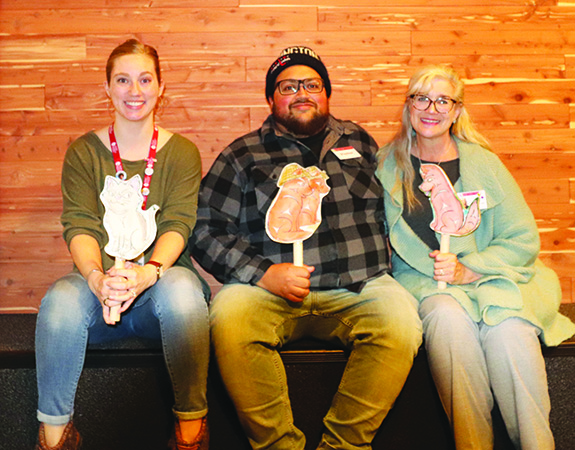
By Micheal Rios, Tulalip News
The Seattle Children’s Museum is a destination place for people from all around the world. Located at the heart of Seattle Center, the always active and engaging museum sees close to 200,000 visitors every year. With a mission to bring to life the joy of discovery for children and their families through creative, hands-on exploration of the world around them, the museum’s heralded Global Village recently debuted an all-new permanent exhibit titled Tribal Tales.
Created by and inspired from the beautifully diverse and thriving Native cultures encompassing the Puget Sound area, Tribal Tales was development over the past two years in direct collaboration with Native artists from Pacific Northwest tribes.
“We thought it would be great if we developed a space that helps us create a real relationship with local tribal communities and members,” explained Amy Hale, director of education for Seattle Children’s Museum. “The artists we collaborated with drew from their own individual experiences in order to create culturally relevant representations of their culture.”
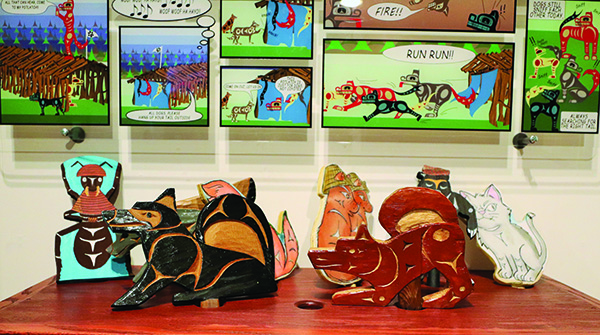
Native storytellers who collaborated on the project include John Edward Smith (Skokomish), Roger Fernandez (Lower Elwha S’Kallam), and Tulalip’s own Ty Juvinel.
“Because of Ty’s trust and active willingness to participate in building up this idea from the very beginning, his efforts had a direct influence on other artists and their willingness to commit,” added Amy. “When I look at this final project, I see not only Ty and his amazing individual pieces, but his influence that led to more artists of other tribal communities working with us and really making Tribal Tales an immersive exhibit.”
Prior to becoming the home of Tribal Tales, the space housed a puppet theatre. The original seed money that created the puppet theatre came via Tulalip Cares, the charitable contributions division of the tribe. It’s only too fitting then that the puppet theatre space was transformed into an interactive, educational exhibit showcasing the richness of Native values and oral tradition, while being co-curated by Tulalip tribal member Ty Juvinel.
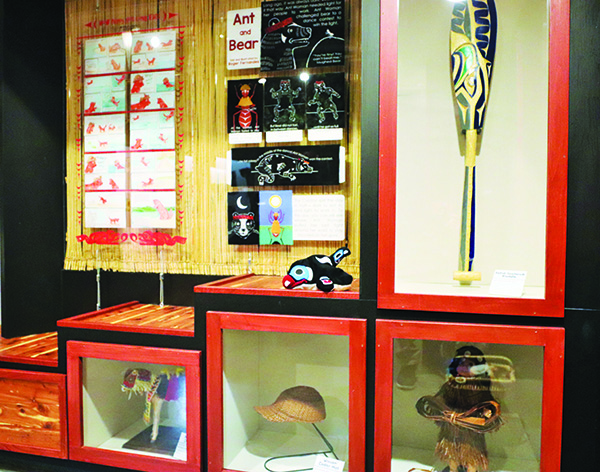
“This exhibit really honors the Indigenous peoples of this land and gives the acknowledgment that our people were here before first contact,” shared the Tulalip storyteller. “Tribal Tales is all about acknowledging the past people that were here while honoring the many Coast Salish tribes thriving today.
“I contributed an original story created for my kids How Puppy Got His Ears, a Salish Sea map detailing all the tribes in Western Washington, a couple house posts, and hand puppets that go along with my story that visiting children can play with,” continued Ty. “The fact the museum got money a long time ago from the tribe and now I’m refreshing the concept for my generation is just awesome.”
Tribal Tales explores the universal art of storytelling through a collective showcase of Native art and culture, curated by the actual artists themselves. “As opposed to white bodies dictating and reflecting back to ourselves what other cultures look like, we gave the artists all the agency to share with us their stories,” added Amy.
The direction and attention to detail is what really makes Tribal Tales stand apart from the many other Global Village exhibits. And for the countless children who visit the museum every day, they’ve already shown a fondness to the exhibit’s bright colors and hands-on puppetry that makes the Native stories easily understood.
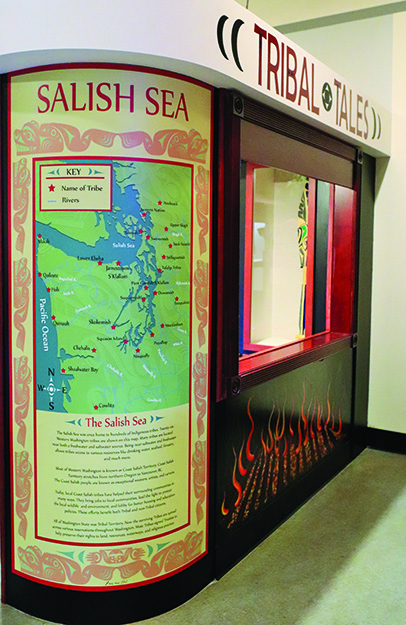
“The Children’s Museum shares all kinds of fantastic things, like science, knowledge and culture,” said Roger Fernandes, sharer of the prolific Ant and Bear story. “I thought it would be a good way to get our stories out there. Each of the stories were illustrated by the Native artists, so the children could not just hear the story but see some visuals that would help them remember it. Ultimately, this project was well thought out and as a result now more kids will have the chance to hear our traditional stories.”
With over 18,000 sq. feet of play space designed for kids ages birth to 8-years-old to enjoy with families, the Seattle Children’s Museum is open Tuesdays – Sundays from 10:00am – 5:00pm. First time visitors are sure to be blown away by the hands-on exhibits and open-ended exploration, especially those who experience the richness of Tribal Tales.
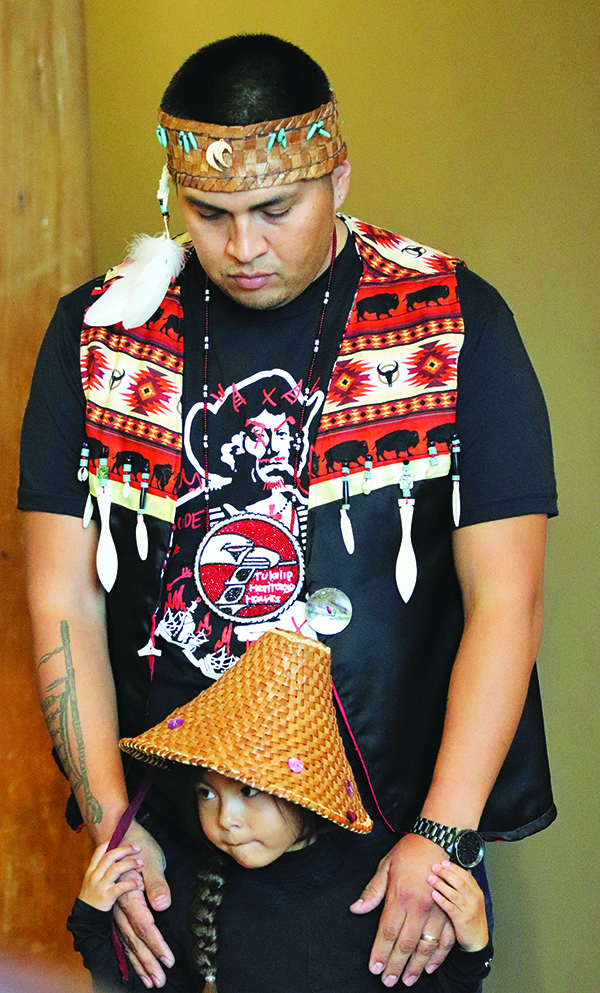
By Micheal Rios, Tulalip News
For the sixth consecutive year, the greater-Seattle area and its thousands of Native citizens celebrated Indigenous People’s Day. Replacing the former misbegotten holiday dedicated to a slave trader and lost navigator, the commemorative day to honor the past, present and future of Indigenous knowledge and cultures takes place annually on the second Monday in October.

“People ask, ‘Why Indigenous Peoples Day and why not American Indian Day or Native American Day?’ It’s only appropriate that we honor the legacy of work that’s been done,” explained Matt Remle. His efforts, along with many other Native advocates, were instrumental in getting a proclamation voted on by the Seattle City Council and signed into law by then-mayor Ed Murray in 2013. “It’s not only honoring legacy, but when we say ‘Indigenous peoples,’ it’s referring to more than just the tribes of colonized United States. We’re talking about all Indigenous peoples who’ve been impacted by settler colonialism around the world.”
Since its inception into the Puget Sound, the Indigenous Peoples’ Day movement has spread to over 120 cities and been embraced by 9 state governments. Even 8 universities and a couple school districts have indoctrinated the holiday to celebrate global Indigenous cultures.
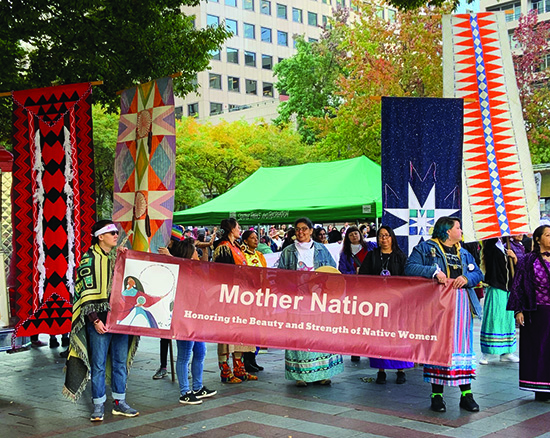
On Monday, October 14, Native people and allies from around the Pacific Northwest gathered at Westlake Park, on ancestral Duwamish land, for a march and rally to celebrate Indigenous Peoples’ Day in Seattle. The dedicated early morning group proudly wore cultural garb and traditional regalia while traversing from Westlake Park to Seattle City Hall, where a rally of celebratory song and dance was held.
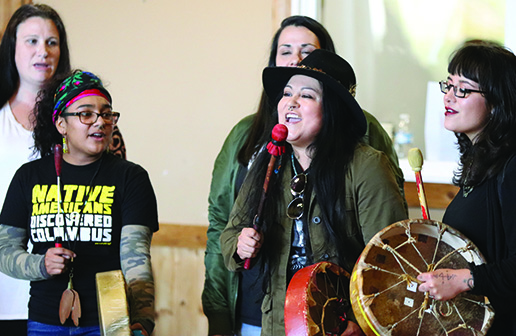
“It’s been a beautiful day to see so many Indigenous people come together and be filled with so much joy,” shared 20-year-old Ayanna Fuentes, a member of Indigenous Sisters Resistance. “Our younger generation is growing up not knowing what Columbus Day is, and that’s an amazing thing.”
In the evening, the festivities continued at Daybreak Star Cultural Center with an honoring celebration for Native nations in the Puget Sound Region and their fellow Indigenous allies. Sponsored by Tulalip Tribes community impact funds, the Daybreak Star gathering included hundreds of urban Natives, dancers from a variety of Indigenous communities, and non-Natives who wanted to share in the memorable event.

The American Indian Movement (AIM) honor song kicked off the evening while Sili Savusa and Feanette Black Bear were blanketed for their longstanding commitments to Indigenous progress. A high-energy hoop dance performed by Ryan Yellowjohn was next, followed by a variety of cultural performances representing Mexico, Chile and the Pacific Islands. For the finale, an overflowing DayBreak Star crowd was treated to several songs offered up by the Tulalip Youth Council.
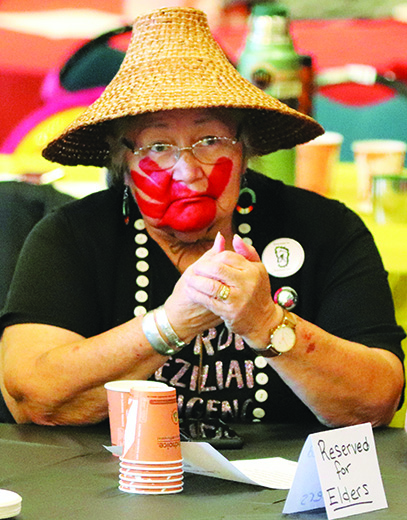
“I thank the ancestors for giving me this opportunity to be here today with you all and hold the sage,” said Feanette. “There are over 500 Indigenous tribes across this country and we are all here because our ancestors said prayers hundreds of years ago for their future generations. It is up to us to stand up and take care of Mother Earth and our relatives all across Turtle Island.”
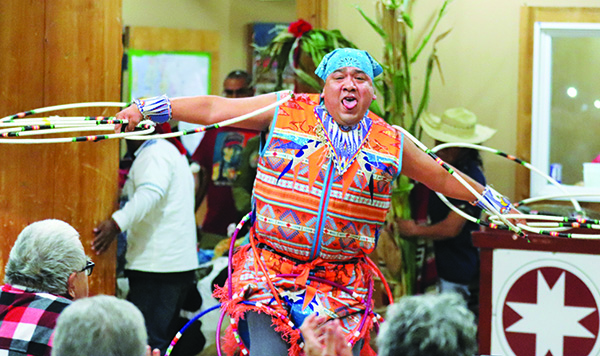
A variety of states, cities, counties, community groups, schools, and other institutions observed Indigenous Peoples’ Day on October 14. They all did so with activities that raised awareness of the rich history, culture, and traditions of the Indigenous peoples of the Americas.
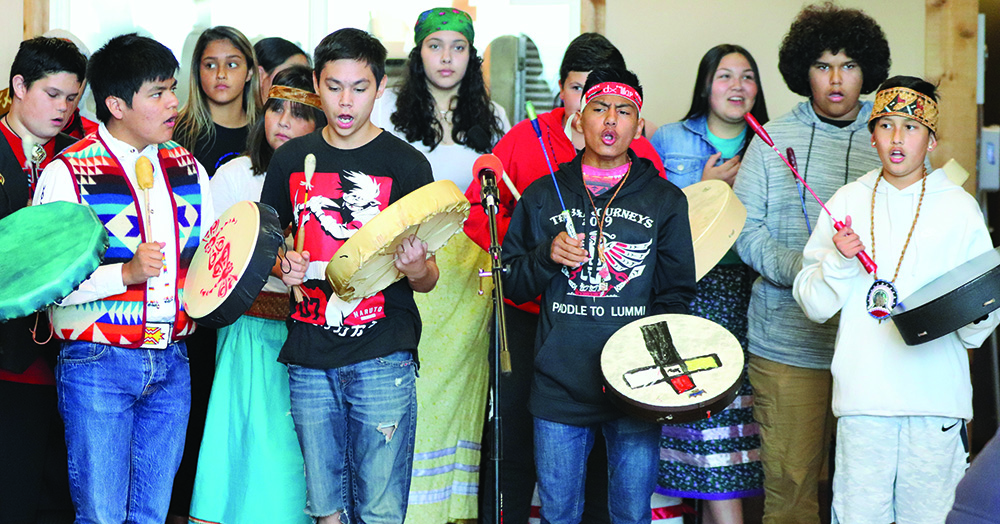
“Indigenous Peoples’ Day, at its core, aims to celebrate and honor the past, present, and futures of Native peoples throughout the United States and acknowledges the legacy of colonialism, which has devastated Indigenous communities historically and continues to negatively impact them today,” stated Native educator and activist, Matt Remle. “More importantly, however, Indigenous Peoples’ Day moves beyond the narrative of oppression and honors the histories, cultures, contributions, and resilience of contemporary Native peoples.”
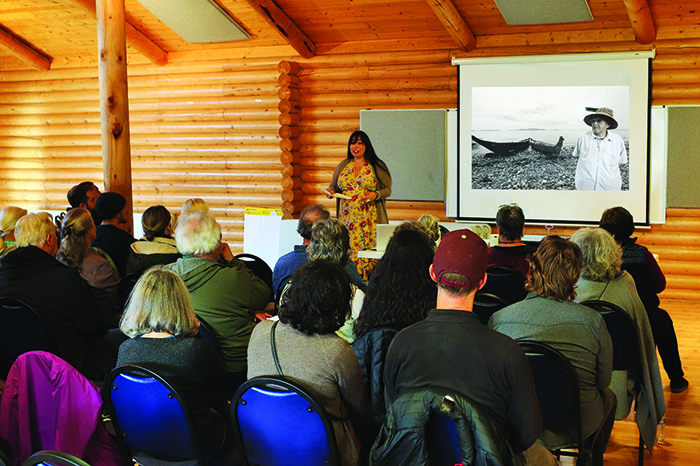
By Micheal Rios, Tulalip News. Photos by Matika Wilbur and Micheal Rios.
In 2012, Tulalip tribal member and visual storyteller Matika Wilbur sold everything she owned in her Seattle apartment and invested the proceeds into a vision: to unveil the true essence of contemporary Native issues, the beauty of Native culture, and the magnitude of tradition. Her vision’s name? Project 562.
Reflecting her commitment to visit, engage, and photograph all 562 federally recognized Native American tribes (in 2012), Project 562 reveals a name that serves to both inspire and educate.
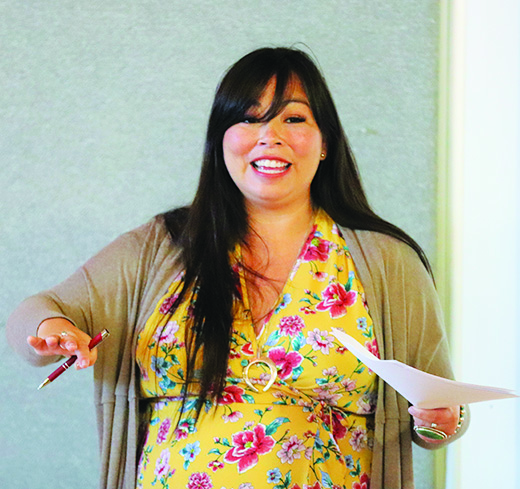
“While teaching at [Tulalip] Heritage High School and attempting to create a photography curriculum with a narrative that our children deserve, I found an outdated narrative,” she recalled. “It’s an incomplete story that perpetuates an American historical amnesia. It’s a story that’s romantic, dire and insatiable…it’s the story of extinction.”
Matika points out the extinction theme often associated with Native America is easily perceived by doing a quick Google Images search. If you search for ‘African American’, ‘Hispanic American’ or ‘Asian American’, then you’ll find images of present day citizens who represent each culture. You’ll see proud, smiling faces and depictions of happy families.
But if you search for ‘Native American’ the results are very different. You’ll see mostly black and white photos of centuries old Natives who are “leathered and feathered”. Making matters worse, you’ll also find more images of white people wearing headdresses than of modern day Native families.
“All of these images and misconceptions contribute to the collective consciousness of the American people, but more importantly it affects us in the ways that we imagine ourselves, in the ways we dream of possibility,” explained Matika.
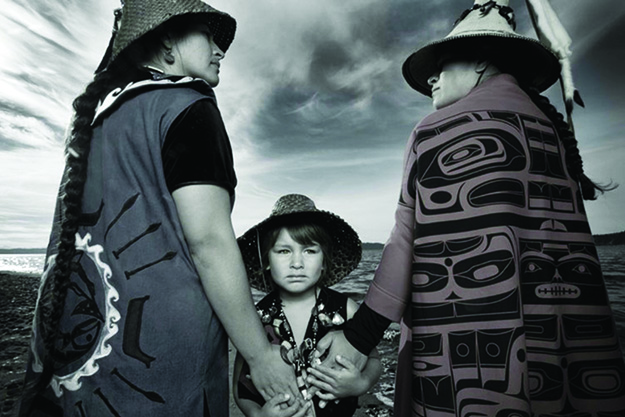
And so began her 7-year journey to photograph and collect stories of contemporary Native citizens from tribes all across the United States. As her photographic portfolio continued to expand, so too did her realm of possibilities.
Project 562 has driven her to travel hundreds of thousands of miles, many in her RV dubbed ‘the Big Girl’, but also by horseback, train, plane, boat and on foot across all 48 continental states, Hawaii, deep into the Canadian tundra and into Alaska. The number of federally recognized tribes has risen to 573, according to the Department of the Interior, since the inception of her vision back in 2012, but that fact is just superficial.
Presently, the now 35-year-old Matika has come to realize that Indigenous identity far surpasses federal acknowledgement. There are state-recognized tribes, urban and rural Native communities, and other spaces for Indigenous identity that don’t fall under the U.S. government’s recognition. Astonishingly, she estimates she has photographs that represent about 900 different tribal communities.
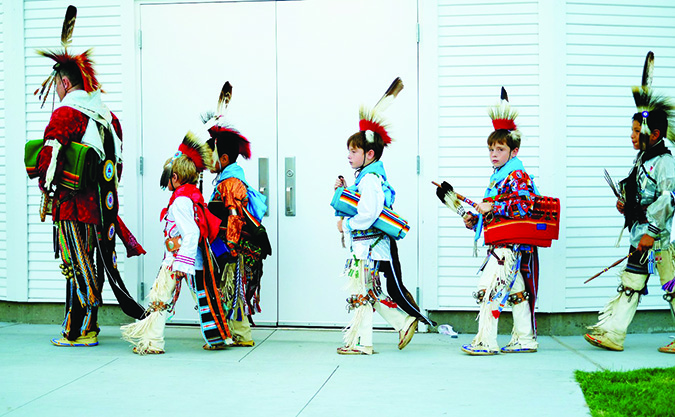
In a respectful way, Matika has been welcomed into hundreds of tribal communities, and she has found that people support the project because they would like to see things change. Conversations about tribal sovereignty, self-determination, wellness, recovery from historical trauma, decolonization of the mind, and revitalization of culture accompany the photographs in captions, videos, and audio recordings.*
“For the past six-years I’ve been sojourning in my big girl. It’s been a whirlwind of a journey, an amazing experience!” beamed the Tulalip photographer who routinely has her brilliant images displayed in museum galleries and college campuses across the nation.
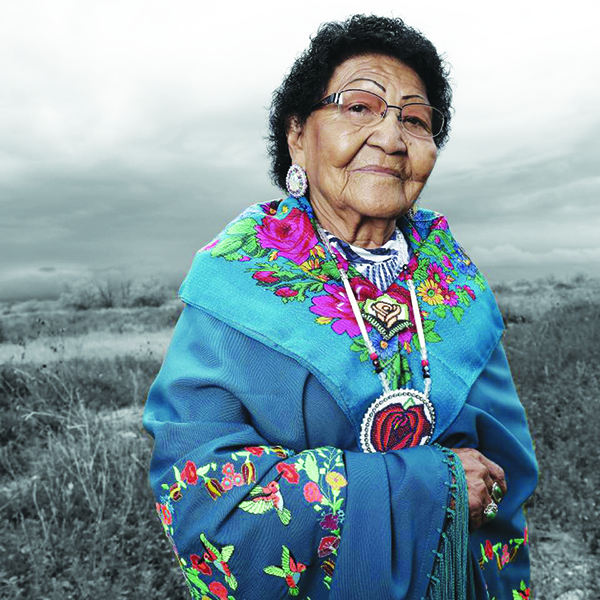
“I started in Washington and worked my way south through Oregon, California, Arizona, and New Mexico,” she detailed. “I went to all the pueblos, so many places in Navajo Nation, then down to the south and into the bayou. I continued on to the Everglades and then all the way up the East coast into Haudenosaunee country where I learned about the Great Law. I then zig-zagged across through the country until finally making it up to Alaska. Now, I am back home.”
She’s returned with an unprecedented repository of imagery and oral histories that accurately portray present-day Native America. Project 562 will ultimately culminate as an awe-inspiring hardcover, series of exhibitions and online resources filled with a dynamic variety of proud Native Americans telling their stories their way. But until that long-awaited day comes, Matika gave adoring fans and devote followers of her project a glimpse into her 7-year journey during the first weekend of October. From October 3 – 5, she held a four-part project preview at Northwest Indian College, Ferndale Library, Nooksack Community Building and the Deming Library.
The Project 562 creator spoke passionately at each venue while sharing stories about overcoming historical inaccuracies, stereotypical representations, and silenced Native American voices in mass media. She shared about meeting one of her real life heroes John Trudell, being at Standing Rock during the 2016 Dakota Access Pipeline protests, and offered powerful stories detailing Native citizens from around the nation rising up from racism and injustice to create a better world for themselves and future generations.
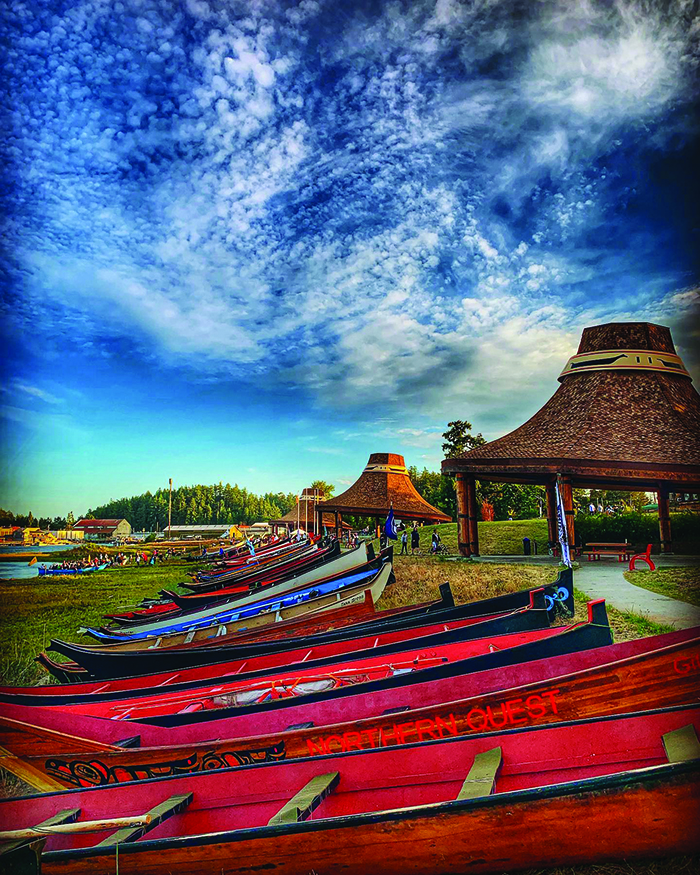
“If I’m here to bring a message at all, it’s the message that Indian Country is alive and well,” said Matika during her NWIC presentation. “It’s the message of hope and resiliency. It’s the story of Indigenous intelligence.
“There are still Ghost Dances, Sun Dances and long houses filled with songs and traditional medicines. Our story is worth knowing, telling, and inspiring one another with. Because doing modern things while gathering and encouraging the collective consciousness to uplift Indigenous intelligence is the only pathway forward. That is the dream.”
*Source: matikawilbur.com
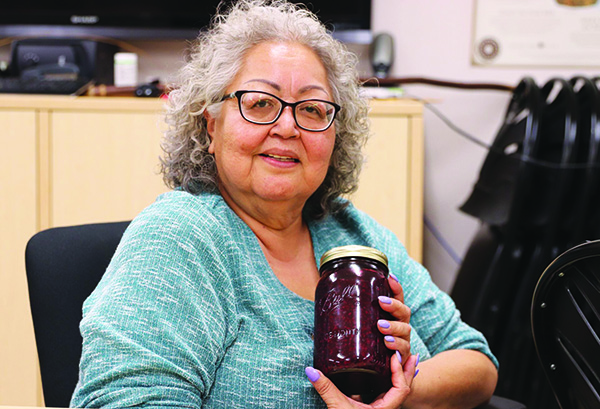
By Kalvin Valdillez, Tulalip News
“I remember my aunt, she stood up once to speak at a gathering. She was talking about our Indian food, or lack thereof, and asked ‘what am I supposed to feed my inner-Indian, spaghetti?” recalled Tulalip Elder and Rediscovery Program Coordinator, Inez Bill, while letting out a small chuckle. “That always stuck with me. And also, when Chief Seattle said, ‘when the tide is out, our table is set.’”
For nearly fifteen years, Inez has led the Rediscovery program, reincorporating a number of cultural aspects that were once considered common, back into the practices of the modern-day Tulalip tribal community. Through colonization, assimilation efforts and the decades of generational trauma that followed, many of these teachings were lost, or kept closely and taught within individual families.
A relatively recent revitalization resurgence saw the art, language and true history of the Northwest tribes come to light and today those cultural traits are often recognized and celebrated throughout the area. And while our lifeways such as fishing, hunting and gathering are rights that may be known to the general public, the spiritual connection to that work is an experience that is unique to the Coast Salish people.
The Rediscovery program has put an emphasis on helping Tribal members, youth to elders, experience that connection by hosting hands-on workshops at local events, teaming up with several departments to spread their teachings. If you’re lucky, you may have made lip balm or salves out of local Indigenous plants with Inez and her team, while learning about the medicinal purposes each plant contains. Or perhaps you attended Mountain Camp as a youth and learned the many uses of cedar, carving walking sticks and weaving baskets. The program also oversees the Tulalip family canoes Big Sister, Little Sister and Big Brother, awakening them every spring, preparing them for Canoe Journey and putting them back to rest after the summertime event ends.
“Our people have learned and passed things on generation after generation through oral teachings,” explained Inez. “Our teachings are not made up, I’ve heard what I heard many different times. If you go to Upper Skagit, Swinomish, Lummi, Tulalip, you hear the same thing and that’s how you know it’s a teaching.”
Inez is always willing to pass on her knowledge of traditional Salish foods. Long before western civilization arrived to the region, the land was abundant with resources, with tall cedar trees encompassing the land, huckleberries high up in the mountains, elk that walked amongst the forests and salmon that populated the Salish Sea in large numbers. The tribes of the Northwest cared for those resources, ensuring that their people would be provided with sustenance for generations to come.
“Native foods were how our people remained healthy for years,” she said. “As a young girl, I grew up going to the winter ceremonies at our smokehouse and celebrated the spiritual life. During those ceremonies, I worked in the kitchen with some of the older lady cooks. There are a lot of things I learned from them, as well as from my parents and grandparents. It was there where I learned how to gather and prepare some of our traditional foods.
“When we serve you our Native foods, we are giving you our very best. There are teachings and values that go with everything we do. From the hunter preparing for a hunt and the gatherer gathering, knowing it’s going toward a ceremony or whatever work that’s going to take place, that’s their gift to that occasion, to share in the gathering. There were times during my life where my family would host gatherings for namings, funerals, memorials and ceremonies. It was always important to have our Indian food there. I came to know and recognize the food, and you see those same foods today, our BBQ salmon, deer steak, deer stew, clams, canned fruit, clam chowder, oysters and crab. All of that not only provides nutrition for us, but it feeds our spirits and the spirits of our ancestors.”
Any given year there are several celebrations hosted within an Indigenous community and the meal is an integral piece to the ceremony. The food’s flavor, serving size and overall presentation speaks volumes about the hosting tribe. During smokehouse ceremonies, Inez explained that she and the other cooks would set a table full of traditional foods, specifically for the spirits of the Tulalip ancestors, early in the day before any guests arrived.
“We usually had the first table around three o’clock in the afternoon for our ancestors from the other side who came to witness the festivities going on. When we put the food out there, they’re the first to eat. Then when our visitors come, we serve them next, before we eat. We always prepare and serve our best and that shows that we are rich in our resources and shows that we are sharing with our people and visitors.”
Prayers and songs are offered before and after a hunt, thanking the land, Creator and the animal itself for the nourishment. And not an ounce of meat, hide or bone goes to waste; people fashion garb, jewelry and drums from the animal’s remains. And, although it varies from tribe to tribe, the Salish people hold annual Salmon Ceremonies, thanking the fish for its sacrifice at the start of each fishing season.
“How you prepare yourself to conduct that work is just as important as the hunt, as the harvest, if not more. That’s where the berry picking songs come from, to make the work easier and not so difficult. And whatever you’re harvesting, you never let it waste. You take care of it, you honor it, respect it and give thanks, because it will continue to provide for you into the future.”
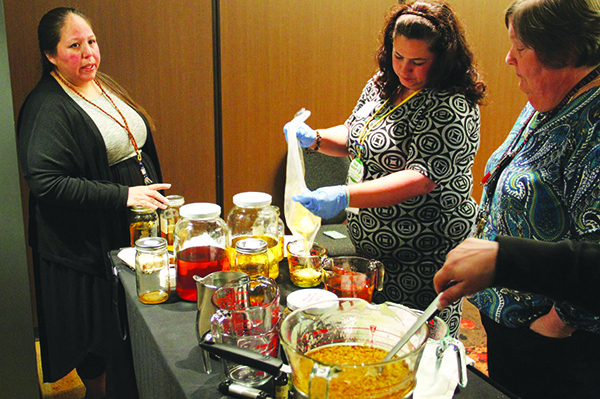
The Rediscovery program hosts traditional foods workshops and during these classes, Inez and crew provide the history of the Coast Salish foods while also showing their participants how the meals were prepared in ancestral time with bentwood boxes and cooking stones. They also prepare an assortment of food samples including teas, seafood, deer and elk meat, and usually a berry dessert concoction as well. Each dish is created combining traditional plants, herbs, berries, nuts and meat with the recipes that are popular in modern times.
“We are always experimenting,” Inez proudly stated while showcasing a large mason jar filled with a berry mixture. “I always wanted to make a pie filling, this was the first year we took time to make this. I think our pallets have changed a lot. Sometimes it’s hard to get people to try something unless its palatable. Our people didn’t have the modern convenience of table salt or pepper. So today, a lot of people will look at those foods and say they are unseasoned.
“If you look at other cultures, such as the Koreans and Germans they have sauerkraut and kimchi, foods that have been fermented. We had fermented foods too, and we haven’t done a lot of experimenting with those just yet, but we know they served a purpose. Like the sourness of Indian ice cream, a soap berry that’s whipped up to the consistency of whip cream. If you ate it today without using some sort of sweetener, it could be considered too sour by some. We like to add apple juice, it makes it more palatable, but I don’t think our ancestors added that to their recipe.”
Inez explained that she began blending traditional and modern recipes when her late husband, Hank Gobin, was diagnosed with diabetes.
“He wasn’t supposed to eat bread. I kept thinking of ways to get him bread. And I found a way to make flour out of hazelnut. It doesn’t have any salt or sugar and we grinded the nuts down to the consistency of flour. He was so happy to get that bread, and since then we kept on experimenting, trying to figure out how to make today’s recipes healthier for our people by substituting some of the ingredients with our Native foods. Or we’ll take a Native recipe and figure out how to cook it in an oven or on a stovetop.”
Today, many people around the globe are attempting to switch back to the traditional diets of their culture. For Native people specifically, that includes giving up many of those dishes that we formulated from government commodities, like frybread and hangover soup. The lack of access to healthy foods combined with the diminishing salmon and wildlife populations have caused serious, and often deadly, health issues throughout Native America. But since many tribes began educating their people about some of the dangers of modern processed foods and incorporating pieces of their traditional meal plans into their diets, diabetes and hypertension are on the decline for the first time in decades for Indigenous people as a whole.
Several tribal and Indigenous chefs have documented their journey in reclaiming food sovereignty. And more often than not, the individual claims to feel better and healthier. However, that is just a start. There are many foods that we have grown accustomed to over the years that can initially be hard to cut out. And until we do so, we may very well continue to have health concerns due to the way foods are manufactured and mass produced.
Now that we are in the middle of the hunting and gathering season, Inez urges the younger people to go out and experience the traditions of the Snohomish people, practice their treaty rights and help provide for their people.
“I marvel at the wisdom of our ancestors to include the right to hunt, fish and gather in the treaty because those are the lifeways of our people,” she stated. “It’s more important to share and do that work for the elders in your family or community in-need. It says a lot of a person who does that type of work. It shows that you must be good people, you listened and learned the teachings of our ancestors. When families do that, they are remembered and those good thoughts and feelings will bring a blessing upon them for sharing with the people. As far as an Indigenous community, that’s exactly what we want to happen. We should continue to rely on our Native foods; the fish, deer and berries. We can’t completely go back to the way it was for our ancestors, but if we went back to a-ways, then we would be a lot healthier.”
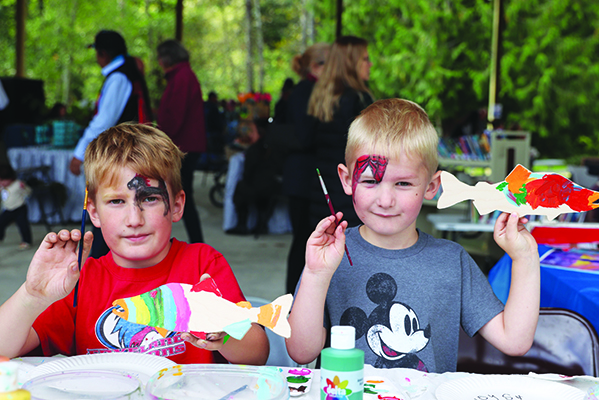
By Kalvin Valdillez, Tulalip News
Approximately 25 miles east of the Tulalip Reservation is the city of Sultan, located exactly at the confluence of the Skykomish and Sultan rivers. After the search of gold brought many settlers to the area, the town decided to pay respect to the chief of the Skykomish at the time by naming the city in his honor, T’seul-Ted, or Sultan spelled out phonetically.
A man of many relations, Chief T’seul-Ted, locally known as Sultan John, had ties to Tribal nations throughout the region, was highly-respected amongst Salish people, and known for his work as a healer. If you’re an outdoor recreational enthusiasts and spend your winters skiing and snowboarding at Stevens Pass, you may have seen Chief T’seul-Ted fishing along Highway 2 as you entered the city, or the 13-foot wooden statue built in his likeness. Every year, for the past eight years, the town gathers at Osprey Park to celebrate Chief T’seul-Ted’s legacy as well as Indigenous culture at the Return of the Salmon Celebration.
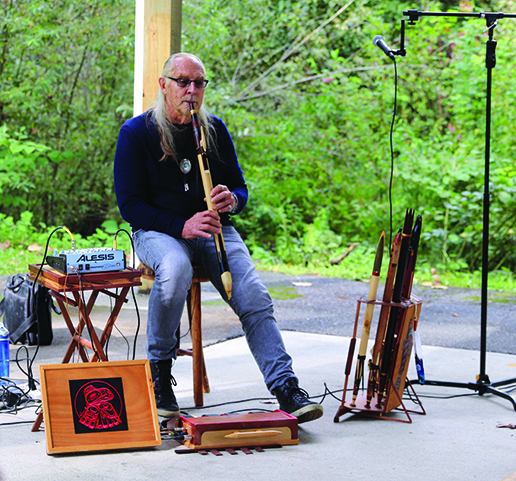
A little rain didn’t prevent the Sultan community from coming out for some family fun time at Osprey Park on the morning of September 28. Since the Washington autumn weather is unpredictable, the daylong event saw a mixture of precipitation and sun rays through the duration of the celebration. Luckily, the majority of the festivities took place under a covered basketball court, allowing the people to stay dry while they feasted on frybread and salmon caesar salads.
“This is our eighth year,” exclaimed Mars Miller, Return of the Salmon Celebration committee member. “It started with Matthew War Bonnet (Lakota), wanting to honor Chief T’seul-Ted as the namesake of Sultan because it often gets lost. This celebration is our way to honor Chief T’seul-Ted and bring back the real history of our area and honor the Native people of the Northwest.”
It’s important to note that along with honoring Chief T’seul-Ted, the community is also commemorating the restoration of the local salmon habitat. The Tulalip Tribes dedicated time, funds and efforts to remove and manage a series of dams, clean up debris and restore riverbeds along the Sultan and Skykomish Rivers for spawning salmon.
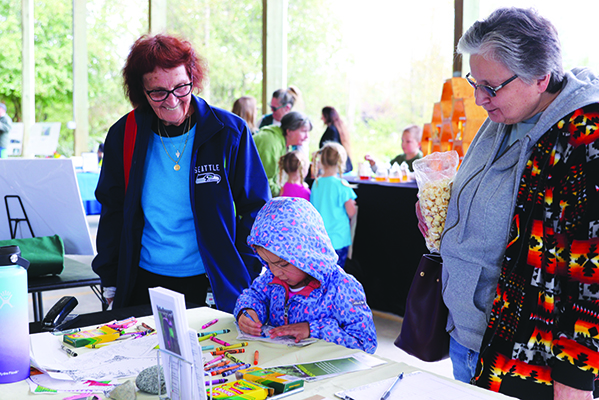
The Return of the Salmon Celebration is a way for locals to learn about the salmon habitat. The city enlists a number of local non-profit organizations, such as Sound Salmon Solutions, to help raise awareness and educate attendees about current recovery efforts taking place around the state. Snohomish County PUD hosts guided tours of the rivers for festival goers to show the environmental work they are doing, monitoring the river’s water quality, temperature and flow.
Every half-hour a horse drawn carriage arrived at the park, picking up those celebrating the return of the salmon and transporting them a few blocks to the Sultan high school. Once at the school, they received a first-hand look at how the students are making strong efforts with Coho salmon recovery.
“Sultan high school has one of the only hatcheries at a school in the state, maybe the whole country,” said Mars. “We are thankful to Tulalip who offers support through a grant to keep that work going because it’s an important opportunity for students to get hands-on experience and learn how to take care of the salmon. And who knows, hopefully from that program some students will find a career path and develop a passion for fisheries.”
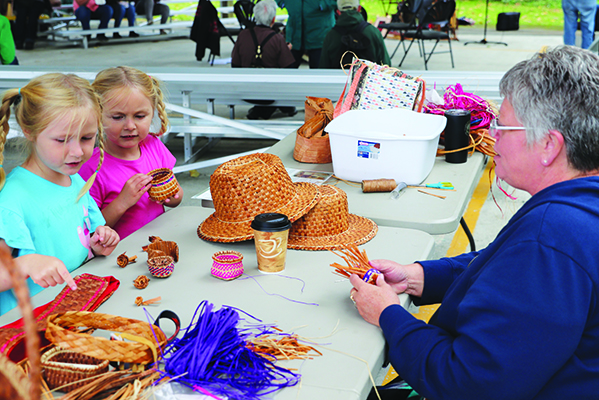
Among the vendors selling jewelry, salves and native artwork, sat Tulalip’s own Taylor Family Basket Weaving. Tribal members Lance and Tammy held a live weaving demonstration that sparked plenty of interest as onlookers watched the couple work their magic, turning strips of cedar into baskets.
“This our fourth year and we just love this event,” Tammy stated. “Usually we don’t travel outside our Native community of Tulalip, but we enjoy being here. It’s a great way to honor the salmon and the Indigenous culture in the Sultan area. We like visiting and hearing stories from the local community who talk about their great grandparents and their lineage. We love the medicine that happens here. We love seeing people enjoy our gift and we love teaching, especially the young kids. Giving back is why we’re here, it’s our duty, we need to let our people know why we do this. ”
A highlight for the kiddos was visiting the arts and crafts station by Skykomish Valley Indian Education. Incorporating the culture of the Snohomish people, the art activities included beading necklaces and bracelets as well as painting cedar salmon blocks.
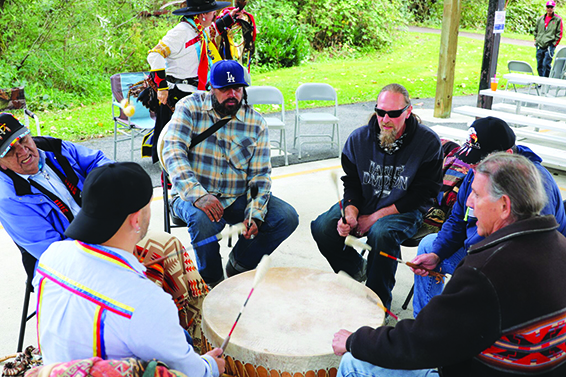
The entertainment for the day included performances by Lummi violinist Swil Kanim, Native American flutist Paul Nyenhuis as well as a mini powwow with beats provided by War Bonnet Drum, a group led by Tulalip tribal member, Don Carpenter.
“It’s our first time here, it’s neat,” said Tulalip Elder, Virginia Carpenter. “My son is drumming here today. It’s a real good event for the kids and a great way to share our culture and get our people together.”
Following the celebration, guests were asked to meet at Traveler’s Park, located off of Highway 2, for a special unveiling. A large boulder was positioned facing the highway and painted on its front was decorated war hero and proud Tulalip tribal member, Sam Wold Jr. Sam served in the Army during World War II, where he received two purple hearts, a silver star and a bronze star for his service. Sam’s medals, gear and uniform are on display at the Hibulb Cultural Center.
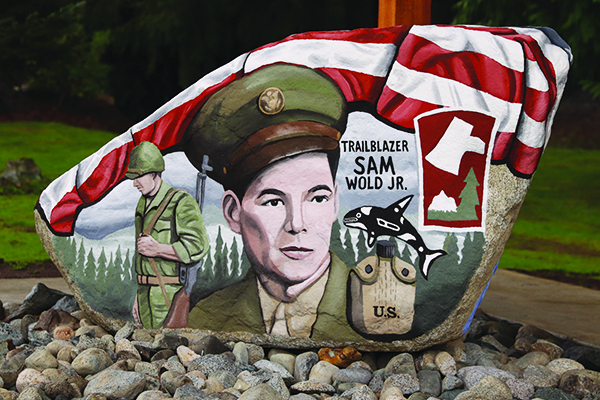
Sam passed away at the age of 81 in 2006. A lifelong local of Sultan, the city submitted an application to the 50 State Freedom Rock Tour, an event created by artist Ray ‘Bubba’ Sorensen II. Initially, Bubba began the project in his home state of Iowa, painting a large boulder to pay tribute to the United States Veterans. Each year, Bubba has painted a new image on the rock to commemorate Memorial Day, dedicating the rest of the year to painting one boulder to honor a veteran in every state. This year’s Washington State freedom rock dedication to Sam was sure to include his Salish roots, as Bubba incorporated the Tulalip killer whale into the painting.
“It was amazing to experience that ceremony and witness that honoring,” said Tribal member Sarah Jean Hart. “To see a Tulalip tribal member honored that way was beautiful and absolutely amazing.”
The 9th Annual Return of the Salmon Celebration will take place on September 26, 2020. For more information, please contact event chairperson, Craig Young for additional information at (425) 359-8936.

By Micheal Rios, Tulalip News
Over 300 hopeful community members united on a Friday evening to bring awareness to Tulalip’s drug epidemic. With a positive outlook and emphasis on prevention, the Get Drugs Off Our Rez walk offered traditional songs, prayer, and stories of encouragement.
In what is sure to be one of the last warmer days of the year, the rain and clouds stayed away on September 27, giving a picturesque backdrop to the gathering as family and friends assembled at Heritage High School’s gymnasium. After many formed a large circle and shared four songs to honor the four directions, the assembly marched their powerful drum beats and strong voices down 27th Ave. NE, or what is colloquially called ‘the Quil.’
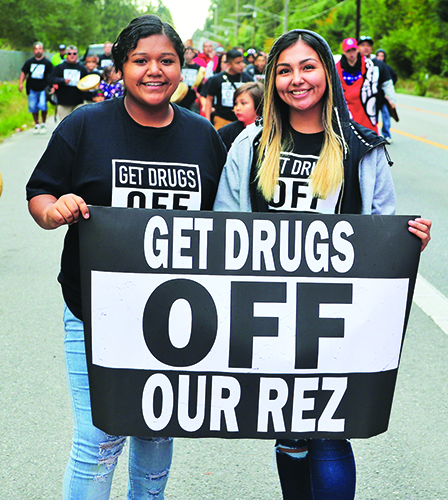
“Today’s purpose was to raise awareness for all of our youth, our elders, and all of our community members. To recognize that there really is unity out here and our people are ready to come together and stay together to build a stronger future,” explained prevention walk coordinator Josh Fryberg. “Personally, I’ve lost family members to the drug epidemic and have other family who are addicted.
“My goal is to get them stronger and get them to where they need to be in order to beat their addictions,” continued Josh. “It comes full circle because by helping those that need our support the most, it shows our youth we still practice our traditional teachings and care for one another.”
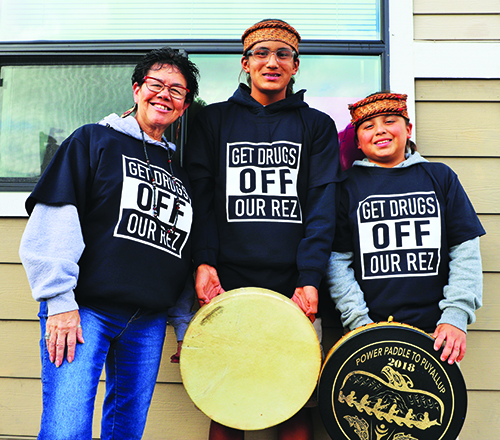
Local law enforcement, firefighters, and various Tulalip-based programs came together with the outpouring of community support to form one unified demonstration. Tulalip tribal members of all ages participated and showed their support for a shared mission by wearing a black t-shirt that stated with all capital letters: GET DRUGS OFF OUR REZ. As they marched down the Quil many local commuters cheered from their cars, while others stood outside their residence to take in the awe-inspiring scene.
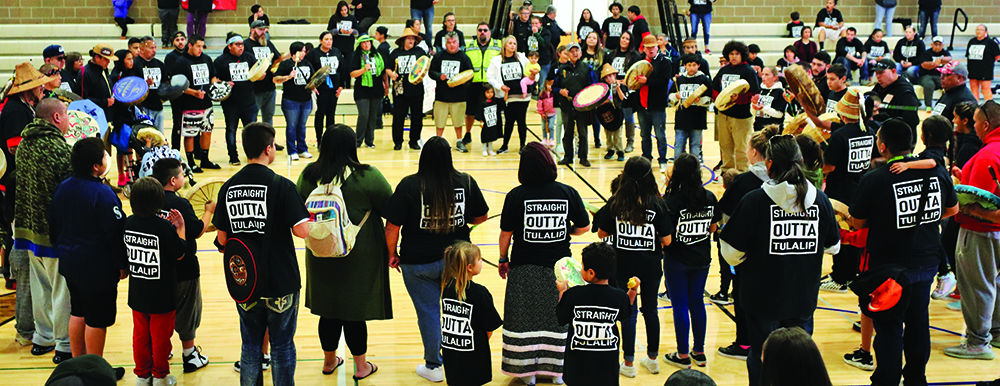
Walking their talk. Voices from the march:
Jobey Williams: “Our ancestors fought for us. They fought for us to have what we have today, and to see so many gather here today to get our people clean means a lot. It shows we’re still willing to fight for one another and get our people together on the right path so we can walk as one. This is just the start, only the beginning, but we are going to get our people back. We are going to help the ones suffering and get them back in the sacred circle.”
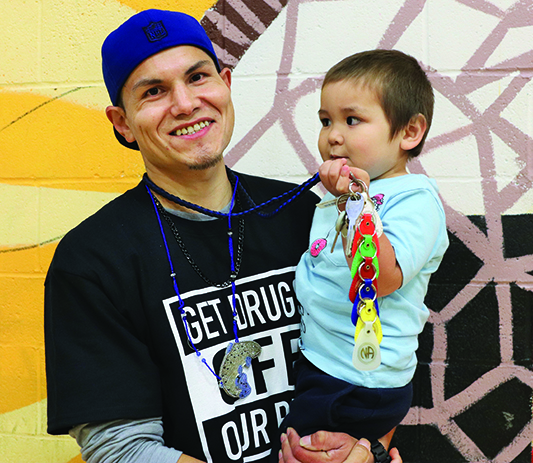
Gerald Williams Jr., with his son Gerald Williams III, celebrated graduation from Wellness Court: “Two years ago I was really bad into my addiction. I weighed something like 110 pounds and using so much drugs that they nearly killed me,” shared Gerald. “Next thing you know my son was born and reality set in that I needed to get clean for him. My father was an alcoholic and his addiction killed him when I was young. I didn’t want my son growing up with that same story so I set out to get clean. It was a struggle and wasn’t easy at all. I had to go through treatment two times to get it right, but eventually it stuck and now I can show my son a better way to live. I’m really grateful for Wellness Court and everyone who helped me get here today.”
16-year-old Kaiser Moses, youth council representative: “When it comes to the drug epidemic, I’ve seen a whole lot and heard much more about what it has done to us. Drugs are keeping us to the sins and vices of the Earth. We need to separate ourselves from that because our ancestors wanted us to be pure and to keep our teachings alive. Our teachings aren’t heroin needles or alcohol. Drugs, alcohol, cigarettes, vaping…all of that is like a snake. You never want to pick up the snake because it will bite you and coil around you, preventing you from being on the good path and walking the sacred road.”
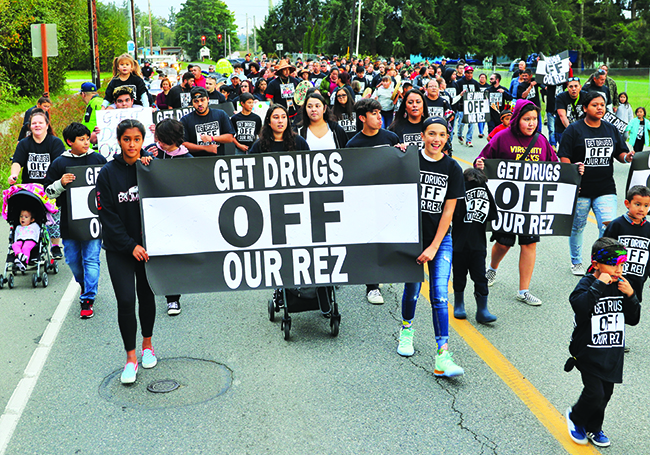
Tulalip Bay Firefighters Peter VanLunsen and Dane Zirwas: “It really empowers us and gives us great pride to serve the community. We often have to respond to not favorable situations, but being here today with the community is a tremendous opportunity.”
Benjamin Deen walked alongside his mother as they both celebrated being clean and sober: “This is so big for our community. This walk is for the future of our children and young ones. I’m carrying my N.A. chips because they remind me that this process is one day at a time. So far I’ve earned my 30-day, 60-day, 90-day, 6-month, 9-month, 1-year and 18-month chips.”

Donald ‘Penoke’ Hatch, Tulalip elder: “When we say drug epidemic we are referring to the heroin, opioid-based pain pills, and cocaine that is sold to our people. It’s poison. The whole community has to help out to solve this problem. If you see things in the neighborhoods, next door, or in your own house, then you have to be willing to talk about it and call the police. I worked hard with one of my children and still lost him, so I know how difficult it can be. Drugs and being addicts isn’t the traditional lifestyle of us as Native Americans. And in order to rid our reservation of those things we have to be willing to speak up and tell on those up to no good. If we’re not willing to do that, then we will continue to have drugs on our reservation. It takes the whole community being on the same page to end this epidemic.”
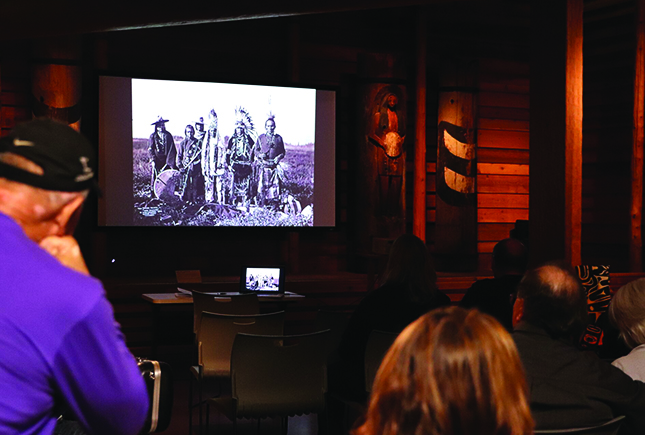
By Kalvin Valdillez, Tulalip News
Cinephiles from near and far gathered at the Hibulb Cultural Center (HCC) on the afternoon of September 21. The always popular film festival welcomed the works of local filmmakers who wished to showcase their modern storytelling abilities with the community. Each year, word about the festival spreads throughout the region, continuingly expanding the list of films on the following year’s docket. Now in its seventh year, the festival saw its largest attendance, as well as the largest number of film submissions to date, supporting local artists and encouraging them to share their stories through film.
“The inspiration behind the festival initially was to celebrate films and filmmaking, to showcase communities in our area and around the world the values that keep them moving forward, and to elevate the perspectives and voices of our community and our ancestors,” said Lena Jones, film festival organizer and Hibulb Cultural Center education curator.
The festival began with a lifetime achievement award ceremony, honoring two Lummi tribal members for their work in the film industry, actor and storyteller Swil Kanim and playwright and filmmaker Darrell Hillaire. Both individuals are locally renowned. Swil is known for many his talents as a violinist and Darrell is the founder and executive director of the multimedia production company, Children of the Setting Sun, which produces contemporary Coast Salish content on film and podcasts. Darrell also allowed HCC to hold an exclusive screening of his new thirty-minute project, Waiting for God, a story of a young Lummi girl’s journey to finding herself, as well as the way back to her ancestral homelands.
“I had the honor of being recognized today, but I represent a whole team,” Darrell expressed. “I’m proud of our team because we’re in the middle of a lot of work and we don’t get to celebrate enough, so we came here to celebrate with the Tulalip people and it means a lot to me. We try to meet the young people where they’re at, with all the technology of today like podcasts and short films, and introduce them to the stories of our ancestors. This a great way to preserve history. As our elders move on to the next life, we need to capture their stories about their time here.”
It was showtime after festival-goers enjoyed a lunchtime feast prepared by Tribal member Chandra Reeves and her daughters, one of whom gave a heartfelt welcome speech to the visitors. For nearly six hours, the attendees were treated to a selection of visual art created by ten filmmakers, both tribal and non-tribal. This year’s viewing had a good amount of variety, ranging in a number of genres, for a total of eleven films.
Inspired after his first submission received a standing ovation at last year’s festival, local music composer and film scorer, Ed Hartman, returned with two new projects this year, including Time for No One, a four-minute short film where Ed displays his piano skills set to images of the World Trade Center. Perhaps his most impressive piece submitted thus far, Ed worked diligently for an entire year, preparing a scored edition of As the Earth Turns, an unreleased Seattle-based silent film made in the late 1930’s. Ed’s music had movie goers on the edge of their seats during suspenseful moments, and fully invested throughout all of the movies emotional scenes.
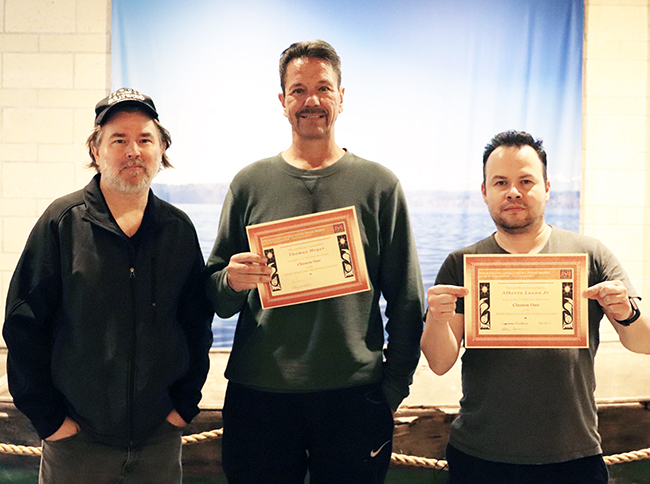
A crowd favorite this year was a fantasy film which involved a battle between elves and vampires titled Chosen One. Written and directed by Thomas Meyer, Chosen One has been featured at several national and international film festivals, winning awards for Best Fantasy at many of them.
Music, paintings, carvings, treaty rights and decolonization were the topics highlighted by eight Native American filmmakers who submitted one project each this year. Over the years, HCC has made it a point of emphasis to encourage local Native creatives to explore the medium of film to express their views and share what it means to grow up Indigenous in the Northwest.
“We’re very proud of our artists and storytellers,” Lena stated. “They remind us of how wealthy we are and how important it is to remember our values. Filmmakers, as artists, help us do that as they share the stories and heroes of our culture. They give us role models of how we can support our environment or our community.”
The art of storytelling has been passed down through the generations since the beginning of time. Our stories are shared to teach youth valuable lessons and they often incorporate our traditional language, dances and songs. Indigenous stories explain the mysteries of the universe like how the sun, stars and moon came to be and emphasize cultural values like respecting our elders, helping our communities and practicing our ancestral teachings. As technology advances, storytellers will continue to explore new forms of storytelling through art, publications, music, film and animation. Attention will be brought to social issues and current world problems like climate change, declining fish runs, MMIW, suicide and overdose, promoting awareness to protect our people, waterways and land, and begin the healing process from years of generational trauma.
Among the many standout Native films was a documentary called A Quiet Warrior, which follows the life and works of the late and highly respectable leader of the Yakama Nation, Russell Jim. Russell was an environmental activist who dedicated his life to protecting the Colombia River waterways. During World War II, a nuclear reservation was established in the nearby town of Hanford where they produced plutonium. Russell fought the U.S. Department of Energy in court to prevent Hanford from becoming a repository for nuclear waste and endangering salmon and local wildlife and habitat.
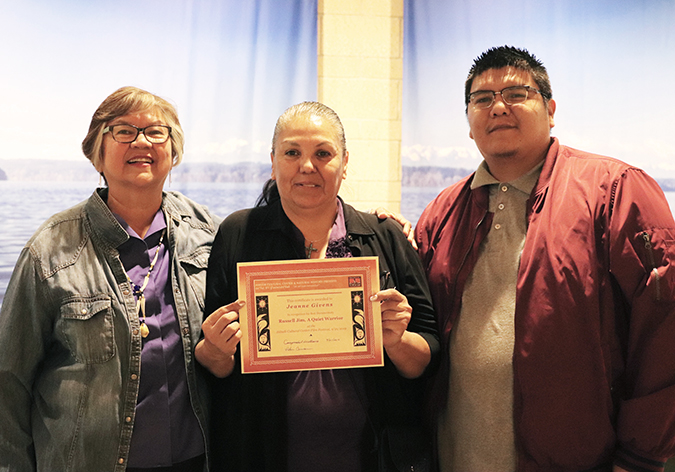
“I met Russell several times and I found him to be such an intriguing individual,” said filmmaker and Coeur d’Alene tribal member, Jeanne Givens. “He was a person who walked in so many worlds, most importantly the political world. He didn’t just know political people, he helped write the Nuclear Waste Regulatory Act, very important work.”
While the film festival carried on through the night, the crowd enjoyed thought provoking and interesting pieces that touched on the effects of colonization, such as We Only Answer Our Land Line by Cherokee and Klamath tribal member Woodrow Hunt, and the two-hour award winning special feature ωαατšι?αƛιν: Coming Home by Brandon Thompson of Huu-ay-aht First Nations. HCC was also sure to incorporate Indigenous art into the program with Makah War Clubs by Jason Roberts, which delves into the traditional weapons of Northwest tribes as well as A Modern Creation Story, which follows Tlingit Artist, Preston Singletary, as he combines the past and the present by creating traditional designs through glass art.
Perhaps the film of the evening, the reception of Could You Imagine? came just as much of a shock to the filmmaker as it was to the attendees. As the five-minute video ended, nearly every person in the HCC Longhouse exchanged stunned looks after they witnessed the works of an artist by the name of MomentumX. Combining many elements of his background, MomentumX incorporated his Swinomish heritage, passion for music, artistic abilities and storytelling talents into one project. Between two long thirty-two measure rap verses, he urged his audience to study their treaty rights and utilize the power of their voice. Not only was MomentumX rapping in the video, he was also spray-painting a large 3-D Salish design onto a canvas. The time-lapse music video impressed the festival attendees who erupted in loud applause by the end of the film. And when Marcus Joe, a young man who sat at the back of the room, introduced himself as MomentumX the crowd rose to their feet and praised him for his talents.
“It’s important that we use our own voice and create our own art,” Marcus expressed. “As an Indigenous youth who grew up in the big city of Seattle, a lot of times I felt alienated and alone. But I always knew who I was and was proud to be Indigenous. It’s important that we tell our stories, our true story, because it was already told wrong once. It’s up to us to set the record straight and let people know who we are in today’s society.”
“He did all of that on his phone,” said film festival judge, Robin Carneen, still in awe over the MomentumX video. “A hip hop Native American film, wow. It just goes to show how prevalent technology and social media is today.”
The film festival aims to preserve the traditional teachings of Native peoples in a modern day format that future leaders can look back to reference or draw inspiration from.
“We hope folks watch the films and are inspired to recognize how important our ancestral culture is to the recent environmental and cultural needs of the nation,” Lena stated. “We hope our younger ones will build their storytelling and technical skills and support their elders work in the communities by sharing important Native perspectives. We hope filmmakers will continue to share their work here and come together for an enjoyable day, viewing the films at our festivals.”
The Hibulb Cultural Center will continue their monthly film series, the next event is scheduled for October 17. For more information, please contact the museum at (360) 716-2600.